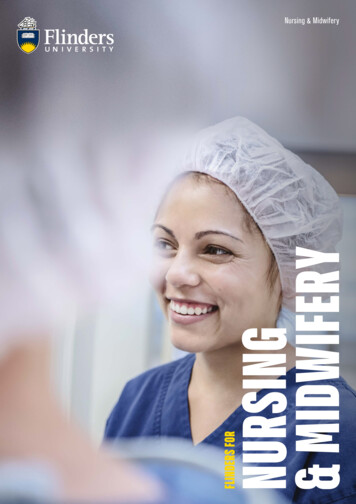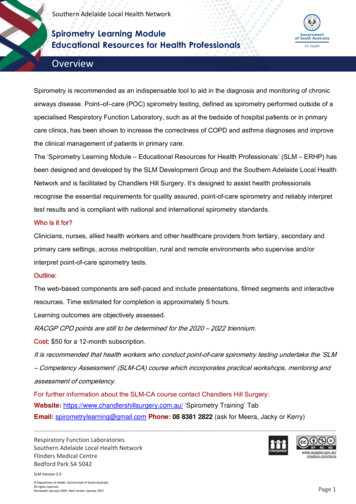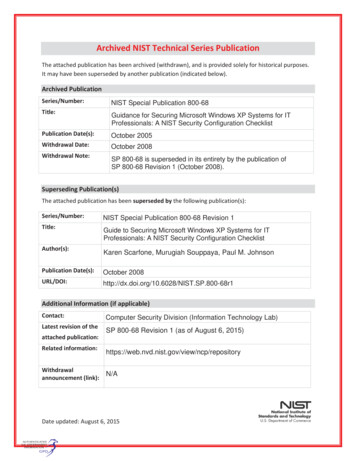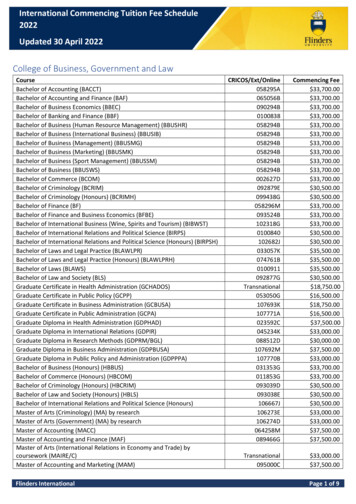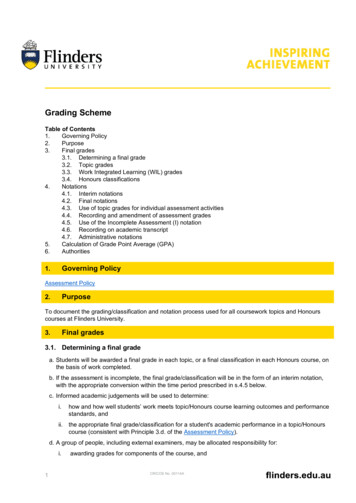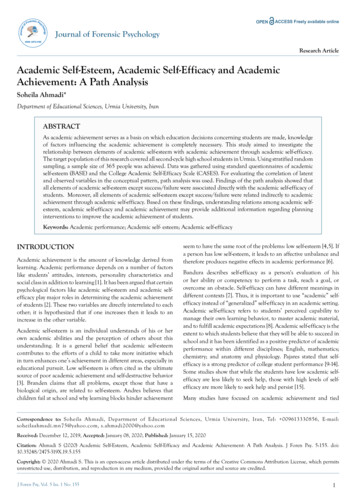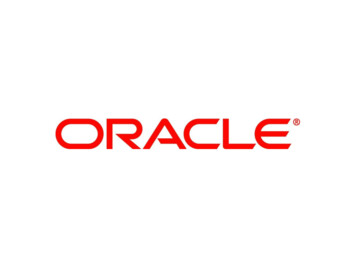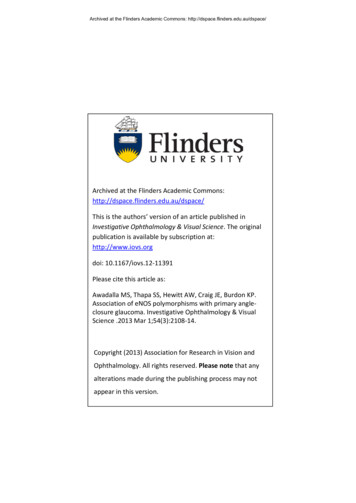
Transcription
Archived at the Flinders Academic Commons: http://dspace.flinders.edu.au/dspace/Archived at the Flinders Academic Commons:http://dspace.flinders.edu.au/dspace/This is the authors’ version of an article published inInvestigative Ophthalmology & Visual Science. The originalpublication is available by subscription at:http://www.iovs.orgdoi: 10.1167/iovs.12-11391Please cite this article as:Awadalla MS, Thapa SS, Hewitt AW, Craig JE, Burdon KP.Association of eNOS polymorphisms with primary angleclosure glaucoma. Investigative Ophthalmology & VisualScience .2013 Mar 1;54(3):2108-14.Copyright (2013) Association for Research in Vision andOphthalmology. All rights reserved. Please note that anyalterations made during the publishing process may notappear in this version.
Archived at the Flinders Academic Commons: http://dspace.flinders.edu.au/dspace/ASSOCIATION OF ENOS POLYMORPHISMS WITHPRIMARY ANGLE-CLOSURE GLAUCOMAMona S Awadalla, MBBS 1Suman S Thapa, MD PhD2Alex W Hewitt, MBBS PhD 3Jamie E Craig, DPhil, FRANZCO1Kathryn P Burdon, PhD 11Departmentof Ophthalmology, Flinders University, Flinders Medical CentreAdelaide, South Australia, Australia.2Nepal Glaucoma Eye Clinics, Tilganga Institute of Ophthalmology, Kathmandu,Nepal.3Centre for Eye Research Australia, University of Melbourne, Royal Victorian Eyeand Ear Hospital, Melbourne, AustraliaCorresponding AuthorDr. Mona S AwadallaOphthalmology Department, Flinders University, GPO Box 2100, Adelaide SouthAustralia, Australia 5000. Phone: 61 8 8204 6985; Fax: 61 8 8277 0899; email:awad0002@flinders.edu.au1
Archived at the Flinders Academic Commons: se: Recently, several studies have investigated genetic associations betweenCytochrome P450 (CYP1B1), Endothelial nitric oxide synthase (eNOS) andNeurotrophin-4 (NTF4) with primary angle-closure glaucoma (PACG) in variousethnic groups. Here we investigate the association of these candidate genes withPACG in samples from Australia and Nepal.Method: A total of 235 patients with PACG (106 Nepalese and 129 Australian) and492 controls (204 Nepalese and 288 Australian) were included. Tag single nucleotidepolymorphisms (SNPs) were selected to cover the majority of common variationwithin the candidate genes and genotyped in DNA extracted from peripheral wholeblood. Allele and haplotype analyses were conducted in PLINK. Bonferronicorrection was applied for the total number of SNPs in this study (p 0.05/15 0.003)Results: In the Australian cohort, one eNOS SNP rs3793342 shows significanceassociation with PACG in the Australian cohort after Bonferroni correction (p-value0.003, OR 0.5 95% CI 0.3-0.8). After adjusting the results for sex and age both SNPsrs3793342 and rs7830 showed significance after Bonferroni correction (p-value of0.001 and 0.003, respectively). The eNOS haplotype of all 7 typed SNPs showedsignificant association with a global p-value of 0.019, with the CGCAATC haplotypegiving a specific p-value of 0.008 and odds ratio of 1.5 (95% CI 0.9-2.4). In theNepalese cohort, SNPs in CYP1B1 and NTF4 genes showed borderline associationwith PACG but did not survive Bonferroni correction.2
Archived at the Flinders Academic Commons: http://dspace.flinders.edu.au/dspace/Conclusions: The present data support the involvement of common variationsin eNOS with PACG pathogenesis. Differences were observed in the two populationsstudied, and additional replication studies in other populations are necessary toconfirm these associations3
Archived at the Flinders Academic Commons: laucoma is the leading cause of irreversible blindness worldwide [1] with primaryopen angle glaucoma (POAG) being the most prevalent subtype. However primaryangle-closure glaucoma (PACG) is responsible for almost half of all glaucomablindness. [2] Family history and ethnicity are important risk factors for PACG. Thedisease is more prevalent amongst Asians and Eskimos than in Caucasians andAfricans. [3] In addition, first degree relatives of patients with PACG have a higherprobability of developing narrow angles. [4, 5] The number of patients with PACGworldwide is expected to rise from around 16 million in 2010 to 21 million by theyear 2020 [6] with the majority of bilaterally blind PACG patients expected to be ofAsian ethnicity. [7]Patients with PACG share certain anatomical biometric features including shortanterior chamber depth with narrowing in the irido-corneal drainage angle, increasedlens thickness and anterior apposition of the lens, short axial length and hyperopic(farsightedness) refractive error. [8]The leading cause of PACG is from obstruction of the trabecular meshwork, whichleads to the accumulation of aqueous humor and subsequent increase in intraocularpressure. This in turn causes progressive destruction of the optic nerve withcorresponding loss of the peripheral visual field. [6]PACG is a complex heterogeneous disease. Recently Vithana and colleaguesconducted a large two-staged genome-wide association study and reported threesusceptibility loci: rs11024102 in PLEKHA7; rs3753841 in COL11A1, and rs1015213located between PCMTD1 and ST18. [9] Prior to this, evaluation of PACG genetics4
Archived at the Flinders Academic Commons: http://dspace.flinders.edu.au/dspace/has been conducted through evaluation of candidate genes chosen for biologicalplausibility or association with similar phenotypes. Several genes have previouslybeen reported to be associated with other subtypes of glaucoma. For exampleCytochrome P450 (CYP1B1) is well known to cause primary congenital glaucoma(PCG), [10, 11] while Endothelial nitric oxidase synthase (eNOS) [12, 13] andNeurotrophin-4 (NTF4) have been implicated in primary open angle glaucoma(POAG). [14] As all three types of glaucoma (POAG, PCG and PACG) arecharacterised by destruction of the optic nerve and progressive increase in thecup:disc ratio, generally with elevated intraocular pressure, we hypothesised thatvariations within these POAG and PCG genes may also be associated with PACG.CYP1B1 is the most common gene known to be involved with the pathogenesis ofPCG. [15, 16] It accounts for around 20% of PCG cases in Australia. [17] Sarfaraziand colleagues [10] hypothesized that CYP1B1 [OMIM 601771] is involved in thedevelopment of the anterior chamber angle of the eye, making it a gene of interest forPACG. Chakrabarti and colleagues [18] sequenced the coding region of the gene andfound association of mutations with PACG in an Indian cohort consisting of 90 casesand 200 controls. A smaller study of 29 PACG patients from the Middle East did notreport any known or novel polymorphisms in CYP1B1, using direct sequencing. [19]Nitric oxide (NO) is synthesized in the vascular endothelium by endothelial nitricoxide synthase 3 (also known as eNOS), from the substrate L-arginine. [20] eNOS[OMIM 163729] over expression is thought to be neuroprotective by causingvasodilation and increased blood flow in human eye tissues. [21] Overexpression ofeNOS was also reported to lower intraocular pressure in the mouse eye by increasing5
Archived at the Flinders Academic Commons: http://dspace.flinders.edu.au/dspace/the pressure dependent drainage. [22] Other factors such as asymmetricdimethylarginine (ADMA) and symmetric dimethylarginine (SDMA) play aninhibitory role in the production of NO. Our laboratory found that serum levels ofboth ADMA and SDMA are significantly elevated in patients with advanced POAGsuggesting dysregulation of the NO system in this disease. [23]Furthermore NO enhances the activity of Matrix metalloprotinase-9 (MMP9) [24]which has also been reported to be associated with PACG. [25, 26] Alteration inMMP9 activity during eye development may lead to hyperopic refractive error whichis a risk factor for PACG. [26, 27] It has been proposed that alteration of eNOSexpression causes impairment of blood flow and subsequent development of angleclosure. The 27-bp variable number of tandem repeat (VNTR) polymorphism inintron 4 of eNOS is believed to alter the production of nitric oxide and cause vascularderegulation. [28] This variation was found to be associated with PACG in Pakistanicohorts. [29] A study of Han Chinese used tag SNPs to identify association ofcommon variants in the eNOS gene in 88 patients with PACG, but no associationswere observed. [30]Heterozygous mutations in NTF4 [OMIM 162662] were recently reported to beresponsible for 1.7% of POAG cases of European descent. [14] Neurotrophin plays avital role in the neuronal cell development, survival and differentiation and it wassuggested that the pathway may also prevent neuronal damage in retinal ganglioncells. [14] Two studies have looked for association with PACG in Indian [31] andCaucasian European [32] populations respectively by sequencing the coding exons,but failed to detect association.6
Archived at the Flinders Academic Commons: http://dspace.flinders.edu.au/dspace/Thus, although these three genes are plausible candidates, results are inconsistentbetween published studies and even less so across ethnicities. Thus, in this study, weaimed to investigate the association between tag SNPs in these three genes andPACG in both Australian and Nepalese cohorts in order to determine if commonvariation in these genes could contribute to disease in these populations.7
Archived at the Flinders Academic Commons: lian Caucasian participants were recruited from Ophthalmology clinics inAustralia through the Australian and New Zealand Registry of Advanced Glaucoma.[33] Approval was obtained from the human research ethics committee of theSouthern Adelaide Health Service and Flinders University. All participants were selfreported Caucasian. The Nepalese cohort was recruited from the Nepal GlaucomaEye Clinic, Tilganga Institute of Ophthalmology, Kathmandu Nepal by one of theauthors (S.S.T). The study was approved by the Institutional Review Committee ofthe Tilganga Institute of Ophthalmology (TIO). All participants were from Nepal anddetailed ethnic group information was collected. [34, 35] This study has beenconducted in accordance with the Declaration of Helsinki and its subsequentrevisions. Informed consent was obtained from each individual.Following the International Society of Geographical and EpidemiologicalOphthalmology (ISGEO) [36] diagnosis of PACG was based on the presence ofglaucomatous optic neuropathy with cup:disc ratio 0.7, intraocular pressure morethan 21 mmHg, peripheral visual loss, presence of at least 180 degrees of closedangle in which the trabecular meshwork is not visible on gonioscopy. In this study129 Australian and 106 Nepalese affected participants were recruited, they were allidentified with PACG.Controls were required to have none of the above characteristics, with no knownfamily history of glaucoma. Participants with pseudophakia or secondary angleclosure glaucoma caused by events such as uveitis, trauma or lens subluxation wereexcluded. The control groups consisted of 288 Australian and 204 Nepaleseindividuals. The Australian control cohort was ascertained from nursing home8
Archived at the Flinders Academic Commons: http://dspace.flinders.edu.au/dspace/facilities in Adelaide, South Australia. Nepalese controls were participants in apopulation based study of Kathmandu, Nepal, in which the individuals were chosenspecifically to be matched for age, gender and ethnic group to the Nepalese cases[34]. Each participant underwent a complete eye examination including; slit lampexamination of the anterior chamber, gonioscopy, best corrected visual acuity,measurement of intraocular pressure, fundus examination with special attention tooptic disc parameters, and visual field assessment. Refraction was carried out using astreak retinoscope (Beta 200, Heine, Germany), which was followed by a subjectiverefraction [34].Genomic DNA was extracted from peripheral whole blood using the QiaAmp BloodMidi (Nepalese samples) or Maxi (Australian samples) Kit (Qiagen, Valencia,California).15 Tag SNPs were selected using the tagger program implemented in Haploview s/haploview/haploview) to cover the majority of known geneticvariation in and around the candidate genes (CYP1B1 5 SNPs, eNOS 7 SNPs, andNTF4 3 SNPs). For the Nepalese cohort, SNPs were selected from the HapMap(http://hapmap.ncbi.nlm.nih.gov/) Han Chinese in Beijing, China (CHB) sample asthe most closely related population available at the time of the study. For SNPselection in the Australian cohort we used CEU: CEPH (Utah residents with ancestryfrom northern and western Europe). Tag SNPs were chosen using pairwise tagging,to have an r2 0.8 with SNPs displaying a minor allele frequency of 5% in therelevant HapMap II population.Genotyping was conducted using the iPLEX Gold chemistry (Sequenom Inc, San9
Archived at the Flinders Academic Commons: http://dspace.flinders.edu.au/dspace/Diego, California) on an Autoflex mass spectrometer (Sequenom Inc, San Diego,California) at the Australian Genome Research Facility (AGRF), Brisbane. Allanalyses were conducted using PLINK. [37] SNPs were assessed for compliancewith Hardy-Weinberg equilibrium using the χ2 test. Genetic association was assessedunder an allelic model. Analysis is with respect to minor allele of the tag SNPs. Pvalues were adjusted for sex and age using logistic regression. A Bonferronicorrection was applied to each p-value according to the number of SNPs typed in thisstudy (corrected p-value; 0.05/15 0.0033). Haplotype analyses were conducted inPLINK based on the observed linkage disequilibrium blocks, as visualised using the“solid spine” definition in Haploview. [38]We further analysed the association between eNOS and MMP9 with PACG in theAustralian cohort by comparing the combined risk alleles with the protective oneusing chi-square test. The data for MMP9 was that previously published on a subsetof the Australian cohort. [25] We selected the significant SNP from each gene eNOSrs3793342 and MMP9 rs17576.The power of this study at α 0.05 was assessed using the Genetic Power Calculator.[39] The prevalence is similar in both Australian 0.4% [40] and Nepalese cohorts0.43%. [41] Assuming complete linkage disequilibrium between the disease causingvariant and the marker we will have a power of 89% to detect a genotypic relativerisk of 1.3 with a risk allele frequency of 0.2 under an additive model.Results417 Australian and 310 Nepalese participants were enrolled in this study. All cases inthe Nepalese cohort presented with PACG, of which 53 cases were reported to have10
Archived at the Flinders Academic Commons: http://dspace.flinders.edu.au/dspace/had an acute attack. In the Australian cohort 129 cases were identified with PACG(35 with previous history of acute attack). Table 1 displays the demographiccharacteristics and clinical data of the cases and controls for each cohort. No SNPdeviated from Hardy-Weinberg equilibrium in either cohort (p 0.05). The physicallocations of the tag SNPs are presented in Figure 1.The minor allele frequencies and allelic association p-values of typed SNPs in theAustralian cohort are presented in Table 2. Three SNPs in eNOS were found to showsignificant association with PACG; rs3793342, T allele, with p-value of 0.003 (OR0.5, 95%CI 0.3-0.8), rs3918188, A allele, with p-value of 0.014 (OR1.5, 95%CI 1.11.9), and rs7830, A allele, p-value 0.007 (OR 0.7, 95%CI 0.5-1.0). Only rs3793342survived correction for multiple testing of 15 SNP (p-value 0.001). However, afterjustifying the Australian cohort for age and sex, both rs3793342 and rs7830 weresignificant with p-value of 0.001 and 0.003, respectively. One haplotype in the eNOSgene also showed association with PACG in the Australian cohort, with a global pvalue of 0.019. The CGCAATC haplotype conferred risk, with significant p-value of0.009 (OR 1.5, 95%CI 0.9-2.4). This haplotype contains the risk alleles of all thethree nominally associated SNPs (Table 3).When we further analysed the association between eNOS and MMP-9 with PACG in theAustralian cohort, a significant difference in the rate of PACG was found betweenindividuals carrying the risk alleles of both SNPs rs17576 in MMP-9 and rs3793342 ineNOS (105 individuals) with those who do carry the protective allele only (264individuals) with p-value 0.048 (OR 2.8).No statistically significant association was observed across the CYP1B1 or NTF4loci.11
Archived at the Flinders Academic Commons: http://dspace.flinders.edu.au/dspace/The allele frequencies and association p-values of typed SNPs in the Nepalese cohortare presented in Table 4. Two SNP from the CYP1B1 gene were nominallysignificant; rs10916, G allele, with odds ratio 2.1 (95%CI 1.1-4.0, p 0.02), andrs162561, A allele, with odds ratio 2.2 (95% CI 1.1-4.3, p 0.01). Both SNPsremained significant after adjustment for sex and age, however did not surviveBonferroni correction. Similarly in the NTF4 gene one SNP, rs11669977 T allele,showed p-value of 0.04 with odds ratio of 1.5 (95% CI 1.0-2.4) but did not survivecorrection for the 15 SNPs typed. No significant associations were identified witheNOS in this cohort.In the Nepalese cohort, the global p-value for the haplotypes of all five SNP markerstested in CYP1B1 gene was not significant (0.11). However, one haplotype, AGCAC,showed a nominally significant association with PACG with p-value of 0.02 (oddsratio 2.2, 95% CI 0.7-6.7) (Table 5), but did not survive correction for multipletesting of five haplotypes (corrected p-value 0.1). The remaining genes did not showany significant haplotypic association in this cohort (data not shown).12
Archived at the Flinders Academic Commons: mary angle-closure glaucoma is a complex disease, believed to arise frominteractions between genetic variants and environmental effects. Here we chose threegenes targeting different function in the pathogenesis of glaucoma; development ofanterior chamber (CYP1B1), retinal ganglion cell development and survival (NTF4),and regulation of intraocular pressure (eNOS). All three genes have previously beenimplicated in POAG or PCG, and have been proposed as likely candidates forPACG.CYP1B1 is well known for its association with primary congenital glaucoma (PCG).[11, 42, 43] It is expressed in tissues of the anterior chamber of the eye such asciliary body, iris and trabecular meshwork. [29, 30] CYP1B1 was hypothesized totake part in the normal development and function of the eye and is involved in thedevelopment of the anterior chamber angle. [10] Association was found with PACGin an Indian population [30], but not in a Middle Eastern cohort using sequencingmethodology. [19] Here we genotyped tag SNPs to look for common variations inand around the gene. Our study shows nominal association in the Nepalese cohortunder both single SNP and haplotypic analyses, however this association was notconsidered significant given the number of tests conducted. Thus, a larger cohort willbe required to confirm this putative association.When ocular tissues are subjected to stress, nitric oxide (NO) is released from theocular vascular endothelium causing an increase in the ocular blood flow and oxygendelivery to the retina. [44] NO is produced from the endothelial nitric oxide synthase13
Archived at the Flinders Academic Commons: http://dspace.flinders.edu.au/dspace/(eNOS or NOS3) enzyme. NO synthesis sites are abundantly located in the ciliarymuscle and the outflow pathway of normal human eye. It has been hypothesized tobe involved in IOP regulation, either directly through affecting the outflow resistanceat the level of the trabecular meshwork, or indirectly through affecting the tone of theciliary muscle. [45] In addition to a role in IOP modulation, eNOS also affects theblood flow to the optic nerve via altering the dilation of the ocular vasculature,. [46]This could be important in determining the nerve’s response to stress anddysfunction could lead to retinal ganglion cell death. eNOS was shown to besignificantly associated with PACG in our Australian cohort at both the allelic andhaplotypic level, suggesting that NO regulation plays a pathogenic role in PACG.NO enhances expression of MMP9. [24] As we have previously reported anassociation of the MMP9 gene with PACG in this Australian cohort [25] weevaluated the data at both genes combined and show that patients carrying PACGrisk alleles at both MMP9 and eNOS have double the risk of developing the diseasecompared to carrying no risk alleles. As the genetic architecture of PACG isunravelled, more detailed genetic risk matrices could be developed, which will betterpredict which patients with primary angle-closure suspect are likely to progress toPACG and thus require close monitoring.NTF4 variants were reported to have a minor contribution in the pathogenesis ofPOAG. [47] Variations in NTF4 were not associated with PACG in an Indianpopulation. [31] This study reported that the most prevalent variant, A88V, waspresent in controls (4.91%) at a higher frequency than in cases (2.85%) [48] which isopposite to the findings in a large cohort of POAG. [14] Neither of our cohorts14
Archived at the Flinders Academic Commons: http://dspace.flinders.edu.au/dspace/showed robust association at this locus. Thus NTF4 is unlikely to be a risk locus forPACG.In conclusion, we find no evidence for association of NTF4 or CYP1B1 with PACGin either the Australian or Nepalese cohort. SNPs and haplotypes in the eNOS geneare associated with PACG in the Australian cohort. The lack of association of thisgene in the Nepalese may be due to a true negative finding, or insufficient power inthis cohort to detect an effect and larger cohorts will be required to determine this.The NO pathway has long been implicated in glaucoma. The findings here mayindicate common molecular pathways leading to optic nerve susceptibility toglaucoma relevant to both POAG and PACG.15
Archived at the Flinders Academic Commons: tsThis work was funded by a grant from the Flinders Medical Centre Foundation. KPBis funded by a National Health and Medical Research Council (NHMRC) ofAustralia Career Development Award and JEC is an NHMRC Practitioner Fellow16
Archived at the Flinders Academic Commons: http://dspace.flinders.edu.au/dspace/References1. Frick kD, Foster A: The magnitude and cost of global blindness:anincreasing problem that can be alleviated. Am J Ophthalmol 2003; 135: 4716.2. Foster PJ, Oen FT, Machin D, et al.: The prevalence of glaucoma inChinese residents of Singapore: a cross-sectional population survey of theTanjong Pagar district. Arch Ophthalmol 2000; 118: 1105-11.3. Salmon JF: Predisposing factors for chronic angle-closure glaucoma. ProgRetin Eye Res 1999; 18: 121-32.4. Amerasinghe N, Zhang J, Thalamuthu A, et al.: The heritability and siblingrisk of angle closure in Asians. Ophthalmology 2011; 118: 480-5.5. Wang N, Wu H, Fan Z: Primary angle closure glaucoma in Chinese andWestern populations. Chin Med J (Engl) 2002; 115: 1706-15.6. Quigley HA, Broman AT: The number of people with glaucoma world widein 2010 and 2020. Br J Ophthalmol 2006; 90: 262-7.7. Yip JL, Foster PJ: Ethnic differences in primary angle-closure glaucoma.Curr Opin Ophthalmol 2006; 17: 175-80.8. Foster PJ, Baasanhu J, Alsbirk PH, et al.: Glaucoma in Mongolia. Apopulation-based survey in Hovsgol province, northern Mongolia. ArchOphthalmol 1996; 114: 1235-41.9. Vithana EN, Khor CC, Qiao C, et al.: Genome-wide association analysesidentify three new susceptibility loci for primary angle closure glaucoma. NatGenet 2012; 44: 1142-6.10. Sarfarazi M, Stoilov I: Molecular genetics of primary congenital glaucoma.Eye (Lond) 2000; 14 ( Pt 3B): 422-8.11. Stoilov I, Akarsu AN, Sarfarazi M: Identification of three differenttruncating mutations in cytochrome P4501B1 (CYP1B1) as the principalcause of primary congenital glaucoma (Buphthalmos) in families linked to theGLC3A locus on chromosome 2p21. Hum Mol Genet 1997; 6: 641-7.12. Tunny TJ, Richardson KA, Clark CV: Association study of the 5' flankingregions of endothelial-nitric oxide synthase and endothelin-1 genes in familialprimary open-angle glaucoma. Clin Exp Pharmacol Physiol 1998; 25: 26-9.13. Magalhaes da Silva T, Rocha AV, Lacchini R, et al.: Association ofpolymorphisms of endothelial nitric oxide synthase (eNOS) gene with the riskof primary open angle glaucoma in a Brazilian population. Gene 2012; 502:142-6.14. Pasutto F, Matsumoto T, Mardin CY, et al.: Heterozygous NTF4mutations impairing neurotrophin-4 signaling in patients with primary openangle glaucoma. Am J Hum Genet 2009; 85: 447-56.15. Sarfarazi M, Stoilov I, Schenkman JB: Genetics and biochemistry ofprimary congenital glaucoma. Ophthalmol Clin North Am 2003; 16: 543-54,vi.16. Stoilov I, Rezaie T, Jansson I, Schenkman JB, Sarfarazi M: Expression ofcytochrome P4501b1 (Cyp1b1) during early murine development. Mol Vis2004; 10: 629-36.17. Dimasi DP, Hewitt AW, Straga T, et al.: Prevalence of CYP1B1 mutationsin Australian patients with primary congenital glaucoma. Clin Genet 2007; 72:17
Archived at the Flinders Academic Commons: http://dspace.flinders.edu.au/dspace/255-60.18. Chakrabarti S, Devi KR, Komatireddy S, et al.: Glaucoma-associatedCYP1B1 mutations share similar haplotype backgrounds in POAG andPACG phenotypes. Invest Ophthalmol Vis Sci 2007; 48: 5439-44.19. Abu-Amero KK, Morales J, Osman MN, Bosley TM: Nuclear andmitochondrial analysis of patients with primary angle-closure glaucoma.Invest Ophthalmol Vis Sci 2007; 48: 5591-6.20. Karantzoulis-Fegaras F, Antoniou H, Lai SL, et al.: Characterization ofthe human endothelial nitric-oxide synthase promoter. J Biol Chem 1999;274: 3076-93.21. Neufeld AH, Hernandez MR, Gonzalez M: Nitric oxide synthase in thehuman glaucomatous optic nerve head. Arch Ophthalmol 1997; 115: 497503.22. Stamer WD, Lei Y, Boussommier-Calleja A, Overby DR, Ethier CR:eNOS, a pressure-dependent regulator of intraocular pressure. InvestOphthalmol Vis Sci 2011; 52: 9438-44.23. Moilanen E, Vapaatalo H: Noble prize in medicine to nitric oxideresearchers. Duodecim 1998; 114: 2517-20.24. Dumont O, Loufrani L, Henrion D: Key role of the NO-pathway and matrixmetalloprotease-9 in high blood flow-induced remodeling of rat resistancearteries. Arterioscler Thromb Vasc Biol 2007; 27: 317-24.25. Awadalla MS, Burdon KP, Kuot A, Hewitt AW, Craig JE: Matrixmetalloproteinase-9 genetic variation and primary angle closure glaucoma ina Caucasian population. Mol Vis 2011; 17: 1420-4.26. Wang IJ, Chiang TH, Shih YF, et al.: The association of single nucleotidepolymorphisms in the MMP-9 genes with susceptibility to acute primary angleclosure glaucoma in Taiwanese patients. Mol Vis 2006; 12: 1223-32.27. Abdel-Latif AA, Ding KH, Akhtar RA, Yousufzai SY: Effects of endothelinon phospholipases and generation of second messengers in cat iris sphincterand SV-CISM-2 cells. J Lipid Mediat Cell Signal 1996; 14: 147-55.28. Nath SD, He X, Voruganti VS, et al.: The 27-bp repeat polymorphism inintron 4 (27 bp-VNTR) of endothelial nitric oxide synthase (eNOS) gene isassociated with albumin to creatinine ratio in Mexican Americans. Mol CellBiochem 2009; 331: 201-5.29. Ayub H, Khan MI, Micheal S, et al.: Association of eNOS and HSP70gene polymorphisms with glaucoma in Pakistani cohorts. Mol Vis 2010; 16:18-25.30. Liao Q, Wang DH, Sun HJ: Association of genetic polymorphisms ofeNOS with glaucoma. Mol Vis 2011; 17: 153-8.31. Rao KN, Kaur I, Parikh RS, et al.: Variations in NTF4, VAV2, and VAV3genes are not involved with primary open-angle and primary angle-closureglaucomas in an indian population. Invest Ophthalmol Vis Sci 2010; 51:4937-41.32. Liu Y, Liu W, Crooks K, et al.: No evidence of association ofheterozygous NTF4 mutations in patients with primary open-angle glaucoma.Am J Hum Genet 2010; 86: 498-9; author reply 500.33. Souzeau E, Goldberg I, Healey PR, et al.: Australian and New ZealandRegistry of Advanced Glaucoma: methodology and recruitment. ClinExperiment Ophthalmol 2011; 40: 569-575.18
Archived at the Flinders Academic Commons: http://dspace.flinders.edu.au/dspace/34. Thapa SS, Rana PP, Twayana SN, et al.: Rationale, methods andbaseline demographics of the Bhaktapur Glaucoma Study. Clin ExperimentOphthalmol 2011; 39: 126-34.35. Thapa SS, Paudyal I, Khanal S, Paudel N, van Rens GH: Comparison ofaxial lengths in occludable angle and angle-closure glaucoma--the BhaktapurGlaucoma Study. Optom Vis Sci 2011; 88: 150-4.36. Foster PJ, Buhrmann R, Quigley H, Johnson GJ: The definition andclassification of glaucoma in prevalence surveys. Br J Ophthalmol 2002; 86:238-42.37. Purcell S, Neale B, Todd-Brown K, et al.: PLINK: a tool set for wholegenome association and population-based linkage analyses. Am J HumGenet 2007; 81: 559-75.38. Barrett JC, Fry B, Maller J, Daly MJ: Haploview: analysis andvisualization of LD and haplotype maps. Bioinformatics 2005; 21: 263-5.39. Purcell S, Cherny SS, Sham PC: Genetic Power Calculator: design oflinkage and association genetic mapping studies of complex traits.Bioinformatics 2003; 19: 149-50.40. Day AC, Baio G, Gazzard G, et al.: The prevalence of primary angleclosure glaucoma in European derived populations: a systematic review. Br JOphthalmol 2012; 96: 1162-7.41. Thapa SS, Paudyal I, Khanal S, et al.: A population-based survey of theprevalence and types of glaucoma in Nepal: the Bhaktapur Glaucoma Study.Ophthalmology 2012; 119: 759-64.42. Plasilova M, Stoilov I, Sarfarazi M, et al.: Identification of a singleancestral CYP1B1 mutation in Slovak Gypsies (Roms) affected with primarycongenital glaucoma. J Med Genet 1999; 36: 290-4.43. Choudhary D, Jansson I, Sarfarazi M, Sc
intron 4 of eNOS is believed to alter the production of nitric oxide and cause vascular deregulation. [28] This variation was found to be associated with PACG in Pakistani cohorts. [29] A study of Han Chinese used tag SNPs to identify association of common variants in the eNOS gene in 88 patients with PACG, but no associations


